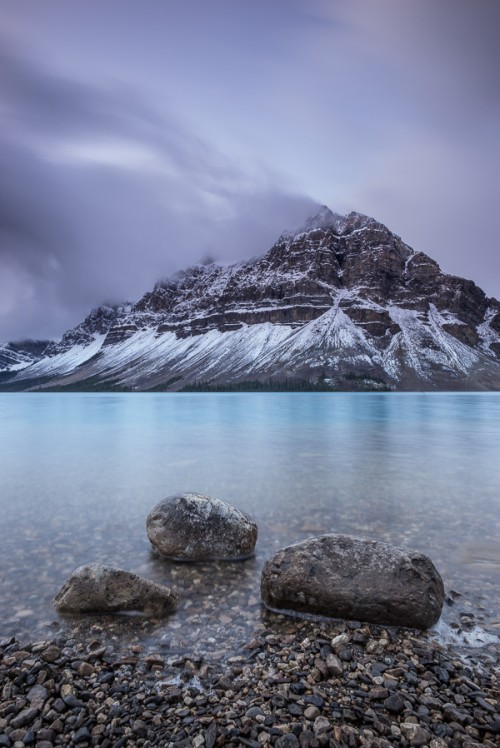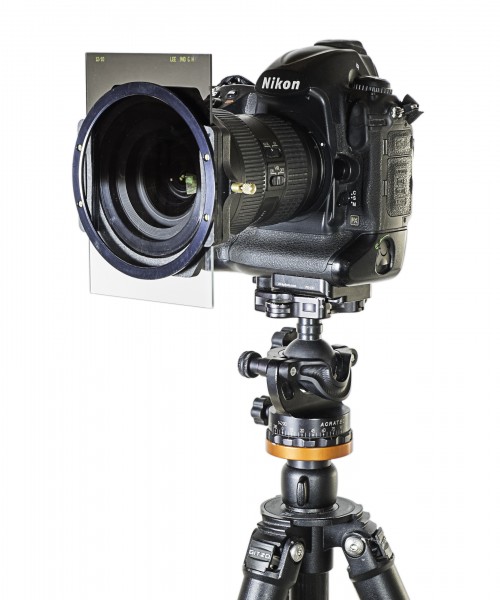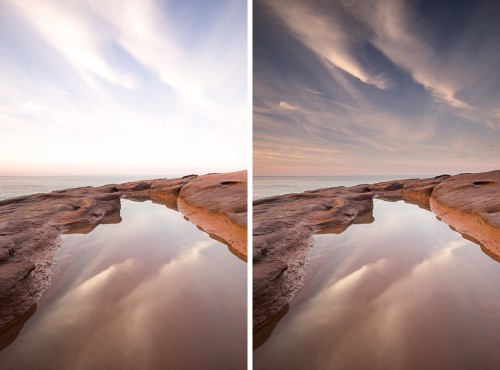 Banff National Park, Canada, 2014. I used both a full and graduated ND for this.
Banff National Park, Canada, 2014. I used both a full and graduated ND for this.
When I first started making photographs, optical filters (the ones you put on the front of the lens, as opposed to software filters) were common. You’d screw them to the front of the lens and it was all pretty simple. When I sold most of my 35mm gear to transition to digital, I sold my filters too, told that “you don’t use filters with digital.” What did I know?
Years later I use optical filters a great deal in my digital photography. There are things you can’t do in Lightroom or Photoshop – like replicate the effects of a polarizer, or a full Neutral Density filter. And if the dynamic range is too great, a graduated ND filter helps you get away from multiple exposures and blending layers later in Photoshop. On top of that, for me, the filters allow me to see possibilities. I can put a filter on, see the results, and react creatively, tweaking this, changing that, until I get something new and unexpected. If I did it later in the digital darkroom I’d be a long way from my scene when a change in direction suggested itself. I still make some frames without filtration, in case, later on, it turns out software is the best tool for the job, but I make those frames once I arrive at the image I want, and using optical filters gets me there.
 My Nikon with Lee Filter holder, polarizer ring (no polarizer) and one 3-stop graduated ND filter
My Nikon with Lee Filter holder, polarizer ring (no polarizer) and one 3-stop graduated ND filter
I’m writing this post is because I really wanted it when I was trying to figure out what I needed and how it all worked together. And I get this question a dozen times whenever I teach. So here’s what I use. But first, a disclaimer – this stuff isn’t cheap. If you want to use cheap filters, go for it – but you spend so much on quality lenses, I’m not sure why you’d want to degrade all that quality by putting cheap plastic in front of your lens.
I use the Lee Filter System. It begins with an adapter ring that comes in multiple thread sizes. That goes on your lens. Then the filter holder, a plastic square into which the filters – up to 3 of them, usually – clips on to that. That’s the basic set up. Now you slide filters into that. Unless you want to use a polarizer, then you need to add a large threaded ring to the front of the filter holder, onto which you can screw a large polarizer, enabling you to polarize a scene while also – for example – using a full Neutral Density filter to give you a long exposure, and a graduated ND filter for pulling the sky back. The filters themselves are usually either 4″x6″, made of high quality resin, or sometimes glass.
I simulated this in Lightroom, because all I had was the final filtered image, but the frame to the left is approximately what this scene would have looked like without a 3-stop hard-transition graduated ND filter
This is my kit, the one I have with me on most days when I’m photographing landscapes, are these, and for me they’re all I need (Amazon links. I do this to be helpful but if you don’t like affiliate links, just search for the same items on B&H or Adorama):
Lee 3-stop (0.9) hard-transition grad ND
And if you have a 77mm thread on your lens, you’ll want this adapter ring, which is specific to wide angle lenses. And here’s a link for an 82mm W/A adapter ring. There are lots of other sizes, I’d recommend getting a couple of these, and cheaper step-down rings for any of the lenses you use less frequently.
I carry it all in a MindShift Filter Hive, which I’ve been using for 6 months now and wish I’d had one years ago. It clips to my belt or tripod and makes keeping it all in one place – and working with multiple filters – so easy. It even holds my filter holder, a lens cloth, and my cable release so everything I need for this kind of landscape work is all in one place.
If you want to go whole hog, here is a link to a complete kit – it might be more than some of you need, but it contains almost everything I use (and then some!), except the polarizer and the ring for the polarizer. It contains the filter holder, a 10-stop ND, 6-stop ND, three hard-transition ND grads, three soft-transition ND grads, and some bits and pieces.
A couple other helpful things:
Hard Transition Grad vs. Soft – I have both. I mostly carry the hard. I just like it better. But when the horizon is really interrupted by trees or mountains, the soft is a little easier to work with. Both is good. I’ll probably dig out my old soft-transition next time I’m out. I just never put it into the filter case.
Other Brands – There are other brands out there. For me, Lee is the sweet spot for quality and price. There’s Singh-Ray, and their quality is off the charts, but they’re pricier than Lee. And there’s Cokin, which I’ve used and will never use again. Unless they’ve stepped up their game, their filters have a (really, really) heavy magenta cast and are poor optical quality.
Colour Cast – Despite the name, Neutral Density filters aren’t always neutral, and you’ll notice a slight magenta cast if you stack them. The more you stack the more cast you get. It’s not (usually) a big deal, I even like that cast sometimes, but it can be alarming if you’re not expecting it. It can be easily removed in Lightroom.
I hope this is helpful. It’s probably still a little overwhelming. I found it confusing. But once I had the pieces – even a few of the basics – I couldn’t believe the difference in my photographs, and the process that got me to those images. Any questions about filters, leave them in the comments of this post and I’ll try to help clear the fog!
Hey, while we’re talking filters, you’ll probably want a tripod. Sure, you could just spend $1200 and buy one with a great ball-head, OR you could put your name in the pot to win one of my faithful Gitzos. It’s in great shape, but a guy can only use so many, so I’m giving one away. More information, and to enter, read this post.


Comments
I hope I win!
Thanks for the tip on the Mindshift Hive, David. It was always a pain having to reach for my filters in my pouch attached to my backpack. This seems to help me solve that.
I just ordered one from B&H. If others are interested, until Nov. 3rd, when you add to your cart you save $5.50 off it for their PhotoPlus sale. Not a lot of savings, but always nice to save.
Good article. The one thing I found – and still find – with filters was the sheer fun experimenting. I’ve had endless fun with a ten-stop filter and if people are moving fast enough, they end up invisible in the image.
I always have a set in the bag and they almost never came off the lens in Iceland!
I agree that it is nice to know that not everyone is abandoning on-camera filters. I also use the Lee system and have been very happy with it. I have a Genus Eclipse Fader that is a less expensive but totally adequate variable ND. My filter storage choice was also less expensive: Lowepro Filter Pouch 100, but in hindsight, the Mindshift is probably worth the extra $. It may be helpful to others to know there are options.
Thanks for the great post. I am relatively new to filters and purchased Lee Seven5 filters this summer. I love using them. They force me to slow down and think about what I’m doing. After making such an investment, It’s discouraging to come online and see that many pros are ditching their ND Grads so it’s comforting to hear the other side of the story.
I also have the Filter Hive. It’s awesome. Stores the Seven5 filters, polarizer, rings, filter holder and my round filters.
Hi David,
I began using the Lee filters (Big Stopper, 0.9ND hard) two months ago and made similar experiences. It really changes my way of photography and the quality of my images. One question: in which situations do you use the 3-stop full ND?
A quick comment on filter kits for the nikon 14-24. I just purchased this absolute beauty of a lens and decided to go with the fotodiox wonderpana free arc system and some of their filters. what i like about the mount to the 14-24 is that it has a 145mm threaded filter holder along with 2 slots to hold slide in 6.6 x 8.5 filters and can rotate around the lens which is great for using neutral density filters. The system is pricey but the quality is outstanding !
If anyone IS curious about going a more affordable route, look into Light Craft Rapid ND / Fader ND (http://www.lcfilter.com), and the B+W or Hoya HD Circular Polariser.
That would come to about $300-$400 depending on filter thread size (less than 50% of the Lee filter set cost).
It’s arguable there is extremely slight image quality loss for pixel peepers, and slight vignetting when pushing 8+ stops with the vari-ND, but this is a very viable alternative for all those looking to get into the world of filters, and one that I am very happy with to this day. I certainly wouldn’t consider these filters cheap plastic, either.
Thanks, Daniel!
Sure like that Gitzo tripod. licked or not, it sure would look good holding my Nikon.
Great post, thanks David.
Hey David! Great post on quality and products.
It is great to see what you’re shooting in real time versus overdoing it in post.
One thing that struck me with quality is that why isn’t there ND filters and other filters built INSIDE our digital tech cameras today?! Why risk the quality of an image and our lens when there could be an alternative in the future.
Something needs to change.
Best Regards,
Matthew
Great blog post David, I thank you 🙂
By the way, you should really link to the new polarizer from Lee instead, it just got released, it’s called Lee Lamdscape Polarizer. They are saying it’s much better on wide angle and landscapes
Thanks for the info Eskil. I am switching over to a 105mm CP and was considering the B&W Wide CP but it’s insanely priced. This new LEE CP is cheaper than their original and supposedly I’ll only loose 1mm on my 16-35 II. I hope they start to come in stock soon.
Your timing with this post is impeccable. I tend to get bogged down making gear decisions, so this saves me a lot of tech-y gear research. Thanks!
I sold all my cheap filters a few weeks ago and I am evaluating what would be my new set, I had been struggling to find the balance between $ and quality, I think some brands are just ridiculously overpriced, considering the results I managed to get from my cheap $45 filter set, recently a good friend purchased a P series cokin set and saw that his pictures had very little to no color cast, so it may be that they fixed their color cast and therefore I am still considering them for my set of grads and nd’s, but on the Z series, not P. For my 10 steps filter I am going to get the Haida ND3. which I have seen comparisons which put other systems to shame in terms on having almost no color cast. I only wished they had nd grads but that doesn’t seem to be available right now.
A colour cast is more easily removed for full ND’s. A bit harder for the graduated ones.